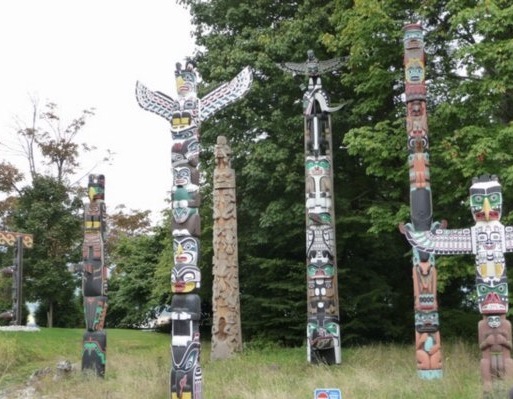Culture as a Tourist Attraction
This photo was taken at Stanley Park on March 10th, 2017. The photo depicts the popular totem poles displayed at Brockton Point. Initially, these totem poles were erected in Prospect Point, but have since then been moved to Brockton Point (Vancouver, 2013). The first of these totem poles were carved in the 1920’s, and have continued to be constructed periodically over the past 9 decades (Vancouver, 2013). Each of these totem poles was carved by an individual from the B.C Coast Salish peoples (Vancouver, 2013). A few totem poles were from the Haida Gwaii region, while almost half of them were purchased from Vancouver Island in the 1920’s (Vancouver, 2013). These totem poles are one of British Columbia’s most visited tourist attractions (Vancouver, 2013). These totem poles and their popularity are representative of how First Nation’s culture has been used as “feel-good tourism” in Canada in the past (Mahrouse, 2011).
Although the journal article ‘Feel-good tourism…’ by Gada Mahrouse discusses the transition of exploiting third-world countries for the sake of tourism to an alternatively socially-responsible version of tourism, the connection it has to First Nation culture is noteworthy. First Nation history and culture has been neglected since the settlers first came to Canada. From religion to traditional ceremonies to even something as basic as the language of First Nation’s peoples, every aspect of their lives has been ignored and shamed. When it has been mentioned, usually it is for the best interest of the country of Canada, and not so much for the First Nation’s peoples. Now, more “socially-responsible tourism is rapidly on the rise,” (Mahrouse, 2011) and global awareness has become more of a focus than ever before.
Despite the fact that socially-responsible tourism has good intentions, some faults are still prevalent. Many socially-responsible tours of poorer countries and communities claim to raise awareness of social issues, which they do. However, they do so only to a degree with which the volunteers are comfortable with (Mahrouse, 2011). The volunteers’ (often white) privilege allows them to experience these social problems in such a way, as well as the global and racial inequalities between themselves and the citizens that are actually living in such circumstances (Mahrouse, 2011). Such privilege, even when acknowledged, is ignorant (Mahrouse, 2011). For example, the participants in the article’s study were aware of their privilege, however, they saw it as their right, and not as their given advantage (Mahrouse, 2011).
Such flaws in socially-responsible tours and the like have been key influencers for First Nations’ Tourism programs in B.C. The tours are all Aboriginal-operated, and allow tourists to experience their lives first hand (Meissner, 2014), such as the Takaya Tours in North Vancouver (Meissner, 2014). The Takaya Tours take the tourists on “guided salmon adventures, nature walks and traditional sea-going canoe voyages.” (Meissner, 2014) These tours allow tourists to experience the most authentic Aboriginal experience, while informing them on Aboriginal culture at the same time (Meissner, 2014). Additionally, Aboriginal communities have the opportunity to become fully engaged with the tourism industry without having their land abused by the public (Meissner, 2014).
These kinds of tours help avoid the interference of social and racial imbalances that regular and socially-responsible tourism can create. By involving the community whose culture is being observed, a more authentic and full understanding is created.
Works Cited
1) Mahrouse, G. (2011). Feel-good tourism: An ethical option for socially-conscious Westerners? ACME: An International Journal for Critical Geographies ,10(3). Retrieved March 22, 2017, from https://ojs.unbc.ca/index.php/acme/article/view/903/926.
2) Meissner, D. (2014, March 17). Bright future awaits for First Nations ‘cultural tourism’. Retrieved March 22, 2017, from http://www.theglobeandmail.com/news/british-columbia/bright-future-awaits-for-first-nations-cultural-tourism/article17537469/
Vancouver, C. O. (2013, April 25). First nations art and totem poles. Retrieved March 22, 2017, from http://vancouver.ca/parks-recreation-culture/totems-and-first-nations-art.aspx
3) Vancouver, C. O. (2013, April 25). First nations art and totem poles. Retrieved March 22, 2017, from http://vancouver.ca/parks-recreation-culture/totems-and-first-nations-art.aspx
